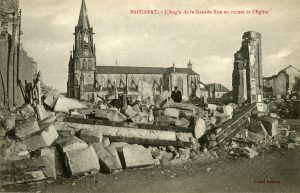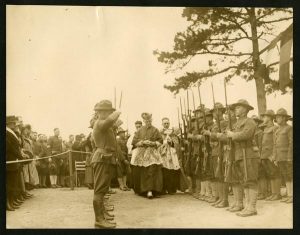
Author Katherine Santa Ana served as Graduate Library Pre-Professional (GLP), 2015-2017.
This year marks the centenary of the United States entering the “war to end all wars.” Here at the American Catholic History Research Center and University Archives, our collections preserve the World War I stories of many men and women through the papers, photographs, and objects they left behind. To mark this major event in American history, we assembled a small exhibit in our reading room highlighting the personal postcard collections of two soldiers and photographs from a scrapbook of a field mass, which took place at Camp Gordon, Georgia March 24, 1918.
Postcards of Robert Lincoln O’Connell
Robert Lincoln O’Connell (1888-1972), a soldier who served for two and half years in the American Expeditionary Force (A.E.F.) of World War I, collected these postcards. As a Machinist in Company C, 1st Battalion of the 1st Engineers, O’Connell survived a German U-Boat attack on the way to France in 1917. He served near Toul, France from January 15, 1918 to April 3, 1918, where the 1st Engineers constructed dugouts, command posts, and wire entanglements as well as quarried rock and repaired roads, often while being shelled and gassed. The First Division then shifted to the Aisne-Marne sector, with the 1st Engineers deployed to the Compiegne forest area. Robert was wounded on July 18, 1918 during the first day of the Allied counterattack at Soissons. After recovering, he returned to service in the Meuse-Argonne and served there until the war ended on November 11, 1918.

Postcards of Bruce M. Mohler
These images of wartime destruction belonged to Bruce M. Mohler (1881-1967), best known as the director of the National Catholic Welfare Conference’s Department of Immigration from 1920 to 1967. Bruce witnessed the destruction of Europe first hand after joining the American Expeditionary Forces in 1918. A Major on the staff of the Chief Engineer Officer, his responsibilities included overseeing the purifying of drinking water for troops stationed close to the battlefront. After the armistice, he served in the Bordeaux region of France before becoming the U.S. Army’s representative to the American Red Cross relief effort in Poland. When a joint Ukrainian and Polish army liberated Kiev from the Bolsheviks in May of 1920, he took a relief unit, clothing, and food, to the refugees of the war torn city. He stayed there providing relief, until Commander Semyon Mikhailovich Budenny and his troops eventually drove them out. Read more about Bruce Mohler and his wife Dorothy in our previous blog post, “Putting Their Money Where Their Hearts Were.”

Field Mass at Camp Gordon, March 24, 1918
Established in 1917, Camp Gordon served as one of sixteen National Army Training Camps prepared for the entry of the United States into World War I. Located north of Atlanta in DeKalb County, Georgia, it functioned as the training camp for the 82nd U.S. Infantry Division. These photographs depict the Field Mass held on the Camp Gordon parade ground Palm Sunday, 1918. Rt. Rev. Benjamin J. Keiley, Bishop of Savannah, officiated and over 10,000 soldiers attended. These images are part of a scrapbook sent to the Historical Records Committee of the National Catholic War Council by a Camp Gordon chaplain. This special committee was created to maintain a national Catholic archives for the preservation and use of materials dealing with Catholic war activities.
Anyone interested in viewing the display in person are welcome to visit the Archives in Aquinas Hall, Room 101. We are open Monday through Friday, 9am to 5pm. For additional information regarding our recent projects to mark the centenary, please see the “Chronicling the U.S. Catholic Experience in the First World War” page on our website and our previous blog post, “For God and Country – American Catholics in the World War.”
